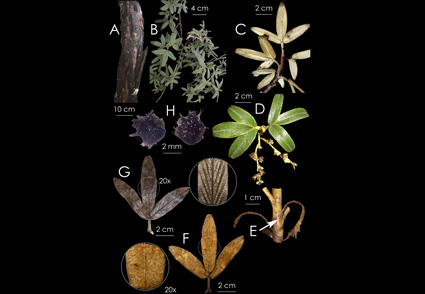Abstract
A new species of Polylepis (Rosaceae) from the Humid Puna of the Bosque de Proteccion Pui-Pui in Junin, Peru, is described and illustrated. The new species was found at 3800 m elevation, in small patches or forest relicts of the natural protected area, growing in open areas highly exposed to wind and abundant fog, along with other shrubby species, mainly Chusquea tessellata (Poaceae). It is very similar to Polylepis canoi but differs by trifoliolate leaves with larger leaflets, lanuginose abaxially, and rounded to ovoid achenes, smaller than those of P. canoi. We also present details on its geographic distribution, ecological notes, and an assessment of the conservation status of the new species.
References
- Amico, G., Vidal-Rusel, R. & Nickrent, D. (2007) Phylogenetic relationships and ecological speciation in the Mistletoe Tristerix (Loranthaceae): The influence of polinators, dispersers, and hots. American Journal of Botany 94: 558–567. https://doi.org/10.3732/ajb.94.4.558
- Beltrán, H. & Calvo, J. (2020) A new species of Nordenstamia (Compositae, Senecioneae) from central Peru. Phytotaxa 474: 293–297. https://doi.org/10.11646/phytotaxa.474.3.8
- Bitter, F.A.G. (1911) Revision der Gattung Polylepis. Botanische Jahrbücher für Systematik, Pflanzengeschichte und Pflanzengeographie 45: 564–656.
- Boza Espinoza, T.E. & Quispe, H.R. (2019) Taxonomic Reevaluation of the Polylepis sericea Complex (Rosaceae), with the Description of a New Species. Systematic Botany 44: 324–334. https://doi.org/10.1600/036364419X15562052252225
- Boza Espinoza, T.E. & Kessler, M. (2022) A Monograph of the genus Polylepis (Rosaceae). PhytoKeys 203: 1–274. http://doi.org/10.3897/10.3897/phytokeys.203.83529
- Carriker, M.A. (1933) Descriptions of new birds from Peru, with notes on other little-known specie. Proceedings of the Academy of Natural Sciences of Philadelphia 85: 1–38.
- Cassini, A.H.G. (1827) Dictionnaire des Sciences Naturelles. Éditeur F. G. Levrault. Strasbourg, 572 pp.
- Chapman, F.M. (1921) Descriptions of proposed new birds from Colombia, Ecuador, Peru, and Brazil. American Museum Novitates 18: 1–12.
- Cuatrecasas, J. (1954) Synopsis der Gattung Wedd. Feddes Repertorium Specierum Novarum Regni Vegetabilis 56: 149–172.
- Fjeldså, J. (1987) Birds of relict forests in the high Andes of Peru and Bolivia. Zoological Museum, University of Copenhagen. Copenhagen, Denmark.
- Fjeldså, J. & Kessler, M. (1996) Conserving the biological diversity of Polylepis woodlands of the Highland of Peru and Bolivia. A contribution to sustainable natural resource management in the Andes. NORDECO, Copenhagen, Denmark, 214 pp.
- Gareca, E.E., Fernández, M., Stanton, S. (2010) Dendrochronological investigation of the high Andean tree species Polylepis besseri and implications for management and conservation. Biodiversity and Conservation 19: 1839–1851. https://doi.org/10.1007/s10531–010–9807–z
- Hágsater, E., Valenzuela, G.L. & Santiago, E. (2019) Epidendrum trullatum Hágsater, L.Valenz. & E. Santiago. Icones Orchidacearum 17: 1753.
- IUCN (2024) Guidelines for Using the IUCN Red List Categories and Criteria. Version 16. Prepared by the Standards and Petitions Committee. Downloadable from: https://www.iucnredlist.org/documents/RedListGuidelines.pdf. (accessed 25 April 2024)
- Jacquin, N. (1760) Symplocos Jacq. Enumeratio Systematica Plantarum, quas in insulis Caribaeis. Inter Documentation Company AG, Switzerland, 41 pp.
- JBM (2014) Jardín Botánico de Missouri. Expedición botánica al Bosque de Protección Pui-Pui, Perú. 32 pp.
- Kessler, M. (1995b) The genus Polylepis (Rosaceae) in Bolivia. Candollea 42: 131–171.
- Kessler, M. (2002) The “Polylepis problem”: Where do we stand? Ecotropica 8: 97–116.
- Kessler, M., Schmidt-Lebuhn & Nikolai, A. (2006) Taxonomical and distributional notes on Polylepis (Rosaceae). Organisms, Diversity & Evolution 6: 67–70. https://doi.org/10.1016/j.ode.2005.04.001
- Kuijt, J. (1988) Revision of Tristerix (Loranthaceae). Systematic Botany Monographs 19: 1–61. https://doi.org/10.2307/25027693
- Lindley, J. (1837) Edwards’s Botanical Register. Vol. 23. James Ridggway and sons, piccadilly, London, pp. 1956.
- Linnaeus, C. (1753) Species Plantarum. Impensis Laurentii Salvii, Holmiae, 560 pp.
- Linnaeus, C. (1781) Supplementum Plantarum. Orphanotrophe, Brunswig, 468 pp.
- Macbride, J.F. (1934) New or renamed spermatophytes mostly Peruvian. Candollea 5: 362–367.
- Mendoza, W. (2005) Especie nueva de Polylepis (Rosaceae) de la cordillera Vilcabamba (Cusco, Peru). Revista Peruana de Biología 12: 103–106.
- Munro, C. (1868) A monograph of Bambusaceae, including descriptions of the all the species. The Transactions of the Linnean Society of London 26: 1–157, t. 1–6.
- Pilger, R.K.F. (1906) Rosaceae andinae. Botanische Jahrbücher für Systematik, Pflanzengeschichte und Pflanzengeographie 37: 534–539.
- Ridbäck, U (2008) A floristic study of Polylepis forest fragments in the Central Andes of Ecuador. Institution en för kultur, energi och miljö Högskolan på Gotland/Gotland University, SE–621 67 Visby, 25 pp.
- Ruiz, L.H. & Pavón, J.A. (1794) Florae Peruvianae, et Chilensis Prodromus. Typis Gabrielis de Sancha, Madrid, 154 pp.
- Ruiz, L.H. & Pavón, J.A. (1798) Systema Vegetabilium Florae Peruvianae et Chilensis Prodromus. Typis Gabrielis de Sancha, Madrid, 456 pp.
- Schulenberg, T., Stotz, D., Lane, D., O’Neill, J. & Parker, T. III. (2007) Birds of Peru. Princeton University Press, New Jersey, 664 pp.
- Sclater, P.L. (1869) On Two new Species of Synallaxinae. Proceedings of the Zoological Society of London 3: 636–637.
- SERNANP (2014) Servicio Natural de Areas Naturales Protegidas por el Estado, Bosque de Proteccion Pui-Pui. Diagnóstico del Proceso de elaboración del Plan Maestro 2012–2017. Gobierno del Peru. Ministerio del Ambiente. 85 pp.
- Sevillano, C.S. & Rodewald, A.D. (2017) Avian community structure and habitat use of Polylepis forests along an elevation gradient. Ecología Austral 28: 216–228.
- Simpson, B. (1979) A revision of the genus Polylepis (Rosaceae: Sanguisorbeae). Smithsonian Institution Contributions to Botany 43: 1–62. https://doi.org/10.5479/si.0081024X.43.1
- Valenzuela, G.L. & Villalba, M.I. (2015) A new species of Polylepis (Rosaceae) from Peru. Arnaldoa 22: 329–338.
- Valenzuela, G.L. (2017) Brachionidium puipuiensis L. Valenz., Lankesteriana 17: 113–118.
- Van der Werff, H. (2022) Andea, a New Genus of Neotropical Lauraceae. Annals of the Missouri Botanical Garden 107: 422–431.
- Weddell, H. (1857) Chloris Andina. P. Bertrand, Paris, 316 pp.


